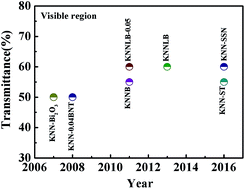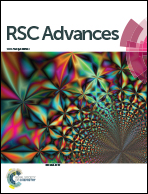Enhanced transmittance and piezoelectricity of transparent K0.5Na0.5NbO3 ceramics with Ca(Zn1/3Nb2/3)O3 additives
Abstract
Considering the environment and human health, highly transparent lead-free (1 − x)K0.5Na0.5NbO3–xCa(Zn1/3Nb2/3)O3 (abbreviated as KNN–xCZN) piezoceramics were synthesized by a solid state reaction method. The effects of Ca(Zn1/3Nb2/3)O3 on the microstructures, phase structures, characteristic frequency and electrical properties were investigated. Fine grain and relaxor-like behaviors were obtained, and the Ca(Zn1/3Nb2/3)O3 also increased the crystal structure of the ceramics transformation from orthorhombic to pseudo-cubic. It was found that the highest transmittance of 70.42% (with a thickness of 0.5 mm in the visible spectrum) was obtained for the KNN–xCZN ceramics at x = 0.07, which was due to the high relative density, low apparent porosity, uniform and fine-grained microstructures, high symmetry of the pseudo-cubic structure, NbO6 octahedron reduced distortion and more relaxor-like behavior. In addition, the transparent piezoelectric ceramics KNN–xCZN with x = 0.07 possessed high transmittance (∼84% at near-infrared wavelengths) and excellent electrical properties (er = 1162, d33 = 102 pC N−1). All of the above demonstrated that the KNN–xCZN ceramics could be promising lead-free transparent piezoceramics.



 Please wait while we load your content...
Please wait while we load your content...